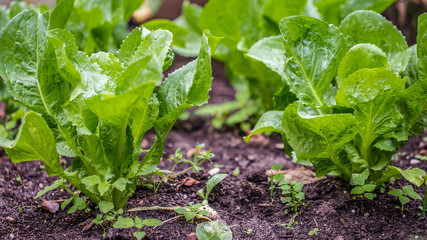Endive (and Escarole) Soil Requirements, Preparation and Planting
Site selection for endive
Soil can rarely be a restrictive factor when we grow endives. The plants can tolerate various soil types but prefer well-drained but with sufficient moisture, loose and fertile loamy and musk soils. Moreover, the crop thrives in slightly acidic to neutral (6 to 6.8) soils but can tolerate a pH from 5.3 to 8.3. While the plants can tolerate some shade (only 2-6 hours of direct sunlight), they perform better in full sun (more than 6 hours of direct sunlight daily). To avoid any persistent problems, such as pressure from pests, diseases, and weeds, endive growers are advised to avoid planting the crop in fields where other closely related species have been cultivated over the past three years.
Soil Preparation for endive
Endives and escarole are usually planted in late fall or early spring (for the Northern hemisphere) as a cool-season crop. Depending on the local environmental conditions, the farmer should select the most suitable planting date to protect the young plants from frost and harvest before the weather becomes too warm (to avoid bolting).
The basic soil preparation starts a few weeks before transplanting the endive seedlings by applying deep tillage, passing with a disk drill, and leveling the land. Plowing improves soil aeration and drainage. At the same time, it improves soil texture, removes rocks or other undesirable materials from the soil, and creates a weed-free seed bed.
One week later, farmers may apply a pre-planting fertilizer (e.g., well-rotted manure or synthetic commercial fertilizer), always after consulting a local licensed agronomist. Most farmers integrate top dressing on the same day, using tillage tractors. Farmers may plant the crop in raised beds 40 cm wide or 1.3 ft (2 rows per bed) in colder areas and fields with a higher risk of waterlogging. There are also cases that up to 4-row beds can be used. Their preparation usually takes place after the incorporation of fertilizers. In areas where irrigation is needed for endive cultivation, the farmers should plan to establish the irrigation pipes before planting. Following the installation, some farmers apply soil disinfection substances (pre-plant fungicides) through the irrigation system in case soil analysis has revealed soil infection problems or/and a herbicide to reduce the population of (perennial) weeds (ask a licensed agronomist in your area).
Outdoors Endive and Escarole Planting and Plant spacing
Depending on the local environmental conditions, the farmer may sow directly in an open field or start their cultivation indoors around 3 to 4 weeks before the desired planting date.
Growing Endive (and escarole) from Seed
Endive seeds require at least 15 °C (59 °F) soil temperature to germinate, while the optimum temperature is 20-22 °C (68-71 °F). Additionally, optimum soil moisture levels are needed to sprout. However, over-irrigation and waterlogging should be avoided.
Endive seeds germinate within 2-15 days, depending on the weather and soil conditions.
Growers in frost-prone areas prefer to sow the seeds in seedbeds under controlled conditions (indoors) and then transplant them into their final positions (open field). In areas with optimum temperatures during spring, growers may sow the seeds directly in the field at ¼ inch (6 mm) depth.
Endive farmers use 1.12-2.8 kg of endive seeds to sow 1 hectare (1-2.5 lb of seeds per acre). Remember that 1 gram of endive seeds consists of approximately 700 seeds (1 ounce consists of 25 seeds).
Growing Endive and Escarole from transplants
As an alternative, endive and escarole farmers may start their crop by sowing the seeds indoors and transplanting the seedling to the open field when they have developed 3-4 real leaves. If this process takes place on the farm, during that period, the grower can start preparing the field as mentioned above (plowing, basal fertilization, and installation of the irrigation system). A farmer may also purchase certified, disease-free seedlings from a legitimate plant nursery.
When sowing directly to the field, the seed can be placed at 0.25 inch or 5-6 mm depth, while when transplanting endive seedlings, it is essential to place them at the same depth as they were at the nursery. A typical pattern for planting is a 20 cm to 30 cm (8-12 inches) distance between plants on the row and a 40 cm to 50 cm (16-20 inch) distance between rows. Higher distances allow the full growth of the plants, while closer spacing may facilitate the self-blanching. Following this pattern, approximately 120,000-130,000 plants will be grown per hectare (55,200-60,000 plants per acre).
Keep in mind that the distances and the number of plants depend on the endive variety, environmental conditions, and of course, the yield goals of the grower.
(1 hectare = 2.47 acres = 10.000 square meters).
Further Reading
10 Interesting Facts about Endive and Escarole
Endive and Escarole: Health Benefits and Nutritional Value
Endive & Escarole Plant Information and Environmental Requirements
How to Grow Endive (and Escarole) at Home
How to Grow Endive -Escarole for Profit
Endive (and Escarole) Soil Requirements, Preparation and Planting
Endive and Escarole Water Requirements & Irrigation Systems
Endive and Escarole Fertilization Requirements
Endive and Escarole Blanching, Yield, Harvest and Storage
Endive and Escarole Pests and Diseases
References
- https://extension.umn.edu/vegetables/growing-lettuce-endive-and-radicchio#bolting-394965
- https://pfaf.org/user/Plant.aspx?LatinName=Cichorium+endivia
- http://www.omafra.gov.on.ca/CropOp/en/spec_veg/leafy_veg/witl.html
- https://horticulture.oregonstate.edu/o
- https://cals.arizona.edu/crop/public/docs/azendive.pdf
- https://horticulture.oregonstate.edu/oregon-vegetables/witloof-chicory-belgian-endive-0
- https://cals.arizona.edu/crop/public/docs/azendive.pdf










































































